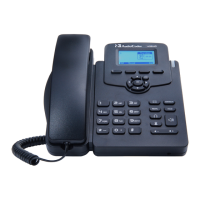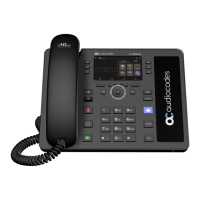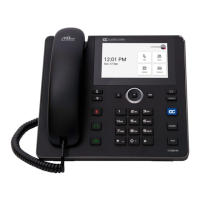400HD Series IP Phones for Skype for Business
Version 2.0.13B 28 Document #: LTRT-08271
• In scenarios where the Admin uses the Handoff softkey to handoff the call to the Boss and
then the Boss tries to handoff the call back to the Admin, the call may fail.
BToE:
• When a paired user presses the phone's mute key, there's no indication in the Lync client's
Conversation window. Moreover, the user cannot mute from the Lync PC client Conversation
window when BToE is running.
• The new BToE PC application v1.0.8 requires users to repeat the pairing process after
installation.
• Call Park can be performed from the phone, not from the Lync client.
• Audio Primary Device:
Switching Audio Primary Device during a call from the Lync PC client to the phone does
not function. This is a limitation of Lync-compatible IP phones. (Audio Primary Device can
be switched from the phone to the PC client.)
During an incoming Lync call, the Primary Device cannot be changed in the Lync
Conversation window. It can be changed when making outgoing calls, and for incoming
PSTN calls.
• Video Calls:
When a paired user has an active video call (e.g., answered from the Lync PC Client),
attempting to answer another call (either from the Lync PC client or with the phone)
disconnects the video call.
An audio call cannot switch to video using the Lync PC client's Start My Video option.
Users trying this option (either local or remote parties) receive the notification message
"Call was not completed or has ended" and the call may be disconnected.
• A paired user cannot merge two calls into a conference call using the Lync PC client's Merge
Calls option.
• After installing BToE, use your Lync client to make conference calls as the IP phone no longer
displays the Conf softkey.
In an environment comprising Exchange Online (as part of Office 365), a call from the phone to a
user who has Exchange Online voicemail may sometimes not reach the voicemail. This issue is
expected to be solved as part of the next version release (May 2015).
The Web interface is not completely Lync-optimized; some screens inapplicable to Lync are still
displayed.
Call Log information is saved to the phone file system once every 24 hours.
Voicemail is supported for Microsoft Exchange Server 2010 and above. A version supporting
Voicemail for Microsoft Exchange Server 2007 will be provided upon a specific request.
With the new dialing method, pressing # doesn't end the dial string. When pressing the speaker or
headset button to initiate the call, the function does work.
When performing a Consultative Transfer, the 'Press Trans to transfer' prompt is displayed briefly
and then disappears.
DHCP Option 160 does not read correctly when there is no "/" (forward slash) at the end of the sent
path.
With the new dialing method, after pressing the digits of a phone number and then picking up the
handset, or, after pressing the digits of a phone number and then pressing the speaker button on
the phone, the number should be dialed. This issue is expected to be solved as part of the next
version release (May 2015).
MPOP (Multiple Points of Presence) - in a Lync environment, each user should be able to have up
to five devices connected simultaneously, for example, PC client, mobile application, and up to
three IP phones.
In some Lync environments, a noise may be heard on the phone when calling a user configured
with 'Simultaneously Ring'.

